Using Your Knowledge of the A Gene In Rabbit Breeding
Many phenotypes — that is, the color of the rabbit’s appearance– are easy to detect just by looking at the rabbit. Some are a bit more tricky. Knowing what the choices are from the parents’ phenotypes (or better yet, genotypes, if you know them), can help you figure out what color an animal actually is.
It can be difficult to tell the difference, for example, between an orange (which is an agouti color), a tort otter (sometimes referred to as an orange otter or a fox) and a broken black tortoiseshell (tort, a self color) that has brighter orange fur, especially if they are brokens. Here are pictures of the three colors for comparison. Broken versions are at the bottom of the page.
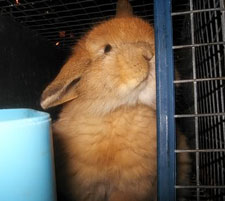 |
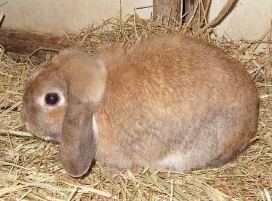 |
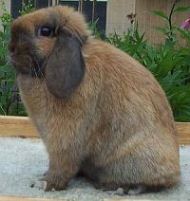 |
|
An Orange. A_ B_ C_ D_ ee |
A tort otter, also known as “orange otter” or “fox” at_ B_ C_ D_ ee |
A self tortoise aa B_ C_ D_ ee |
If you determine that both parents are self colors, then you know that the rabbit is a tortoise who just happens to have a brighter color of fur. If the parents are agouti or otter, you must consider the other options. To determine the true color, in this case, test-breed the questionable colored rabbit to a black rabbit (the best choice is a true breeding black, that is aa BB CC DD EE). If the rabbit produces chestnut babies, it is an orange (the “A” is needed to make chestnut). If it produces a black otter, it is a tort otter and if neither is produced (with a sufficient number of offspring to account for chance), then the rabbit is a broken black tortoiseshell (tort).
Other colors are difficult to determine as well, such as the difference between a sable point and a sable point marten (the rabbit on the below left is a sable point marten, the rabbit on the right is a sable point). Again, if both parents were self, the rabbit would be sable point. If either parent was agouti or otter, then the rabbit could be a marten. A test breeding could help you make a determination in this case as well.
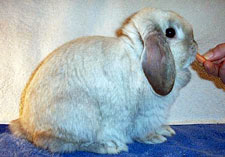 |
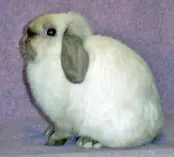 |
| Sable Point Marten
at_ B_ cchlc D_ ee |
Sable Point Holland Lop
aa B_ cchlc D_ ee |
Another great use for understanding the a gene is in the development of otters. Because otters are rarer in Holland Lops (they were culled out as non-showable for years–now we want them back!), your first otter may very well be an otter carrying self (“A-a”).
The Importance of True-Breeding Otters
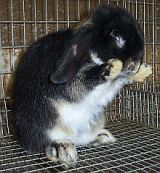
Your first goal would be to produce true breeding otters, that is, otters that have two at genes (at-at) and the correct pairs of the other color genes for the color you are attempting, of course. You can tell from the chart on the previous page that you cannot produce a true-breeding otter from an otter and a self. You can get some true-breeding otters, though, from breeding two self-carrying otters (at-a). But, only 25% of your offspring from two self-carrying otters will be true-breeding otters. Twenty-five percent won’t be otters at all, and that’s easy to determine. But of the otters, you will not be able to tell by looking at them which are the true breeding otters. By watching their offspring, however, you will be able to get a pretty good idea whether they are true-breeding or not. If an otter ever produces even one self baby, it is not true breeding. (You can go to the chart and follow the “at-at” line across or the column down and you will not find one single “a-a” offspring.)
In case it is not apparent, let me specifically state that the advantage to having true breeding otters when you are developing an otter line is that you will more reliably produce otters. You will need the greater numbers of otters to work with in improving their conformity to the standards. Usually this improvement is done by breeding true-to-type black tortoiseshell back into your otter line (which are a-a, of course). If you try to work with self-carrying otters, only half of your resulting offspring would be otter (on the average). I recently had a litter like that with five kits and got no otters at all–how frustrating! Had I a true-breeding otter, all of the kits would have been otters (100% at-a).
The next article offers a chart that helps you compare colors that only differ by the A-series genes.
